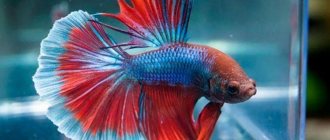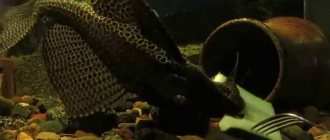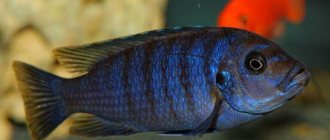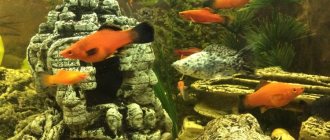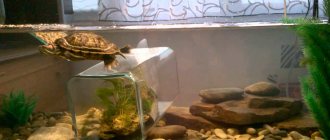Description. How to choose?
The body shape of such fish is oval and elongated in length, and it is also slightly flattened on the sides. The fish is not large, its average length is 6 cm, females are slightly smaller.
The pectoral fins have a pointed shape, while the dorsal and caudal fins have a rounded shape. Males have more developed fins than females. The color of the fish is usually dark brown with green spots, but in the aquarium the richness of color of these fish is unparalleled.
Breeders have bred more than 70 species of such representatives, differing in color and shape of fins. In the aquarium you can see different options of emerald, red, black and pink tones.
Reference! Depending on the shape and size of the fins, there are more than ten types of aquarium bettas. For example, crown-tailed, double-tailed, delta-tailed.
Wherever you buy a betta, you should pay attention to the conditions in which it is kept in the aquarium. It should be spacious so that the fish can swim freely. Keeping it in a jar or plastic container for a long time leads to a state of stress. The water in the aquarium should be clear.
It is best to buy young representatives of this species. Males at this age do not have such luxurious fins as adults, but it is easier for young ones to adapt to new living conditions.
The good appearance of individuals also indicates health and proper maintenance. They should not have torn fins, veils over their eyes, or ruffled scales. They should be active and show interest in the food.
Varieties
The betta fish was first selected in 1910, giving it a colored color. Today there are more than 10 species of betta. They differ from each other in color:
- plain (red, yellow, white, black, blue, turquoise, purple);
- two-color (the color of the fins differs from the body color);
- multicolor (marble color, butterfly, dragon).
And also by the type of fins.
| Betta Over Halfmoon |
Betta crowntail |
| Short-tailed cockerel (Betta Plakat) |
| Veiltail cockerel (Betta Veiltail) |
| Delta-tailed Betta (Betta Super Delta) |
Betta Double Tail |
| Elephant-eared cockerel (Dumbo) (Betta Dumbo) |
Lifespan
The betta fish is a famous aquarium inhabitant that is loved by many people due to its temperament and bright disposition. Its average lifespan in an aquarium is 3–4 years with proper maintenance and nutrition. Some pets can live longer, it depends on the conditions created by the owner.
Reference! If you have betta fish in your aquarium, you should treat their maintenance responsibly, as they need the attention and care of the owner.
How to determine how old a fish is?
Sellers in pet stores cannot always tell how old these types of fish are. Determining age on your own is problematic, but using the tips below, you can give an approximate estimate:
- Determine age by size. The closer the fish is to its optimal size, the older it is. For example, if you buy a rooster 4 cm long, then it is still a young individual.
- Determine age by external signs. Adult representatives have large fins.
- Determine age by color. With age, the color of the fish fades, so older representatives are very different from their younger relatives.
How long can a betta fish live in an aquarium without oxygen?
The betta fish absorbs atmospheric air, floats to the surface from time to time, swallows a bubble of air, from which it extracts oxygen. Such representatives are not demanding in terms of care, but cleanliness must be maintained. Three liters of water will be enough for one fish.
Reference! They are often purchased as a single aquarium pet. But algae, grottoes and good lighting in the aquarium will make their life more joyful.
Water changes should be carried out as in the case of other types of fish:
- at least once every seven days;
- If the aquarium has a volume of up to five liters, then fresh water should be added a couple of times a week.
How many years does a betta fish live and how to extend its life?
join the discussion
Share with your friends
The betta fish can become a real decoration for your home aquarium thanks to its colorful and spectacular appearance. But before you start one, you need to familiarize yourself in detail with the needs and preferences of this type of aquatic living organisms. It would also be useful to find out how long this fish can live in your aquarium.
How to properly maintain it so that it lives longer?
Her life expectancy is influenced by many factors:
- Environment - pets must be placed in a pre-prepared aquarium, otherwise they will live for several days. Vegetation is planted in the container to produce oxygen and for the fish to snack on the algae.
- Nutrition - cockerels are omnivores, but special attention must be paid to feeding: meals should be regular and the amount of food should be moderate.
- Equipment - a filter for water purification and a heater in the aquarium are required.
- Neighborhood - in order for representatives of this species to live longer, you need to select the right neighbors for them.
- the water temperature in the aquarium from 26 to 29 degrees Celsius.
Requirements for pets' place of residence
Place soft plants in the aquarium, while at the same time leaving access to the surface where the fish can take a sip of oxygen (the betta has not only gill breathing, but also labyrinthine breathing).
Do not decorate the pond with elements that have sharp corners or details, and do not install the aquarium in a draft or direct sunlight.
Maintain the water temperature at 26-28°C, excluding sudden changes even in the range of 2-3 degrees.
Do not fill the aquarium to the brim, leave 7-10 cm, and cover it with a lid (this will allow the fish to breathe warm air).
You should not put more than 1 male in an aquarium, because betta fish are aggressive and will definitely start a fight. Only in large reservoirs the number of males can be increased to two.
The cockerel prefers to live in a small aquarium (but not less than 4 liters). In such a reservoir, a fight can be prevented only by separating one male from another with a glass partition or mirror.
Adverse factors that shorten life
Many factors negatively affect life expectancy:
- Small aquarium volume . Individuals of this species need to constantly move; there is no need to put them in tight containers that limit their activity.
- Lack of plants in the aquarium . Fish need oxygen, which comes from algae.
- Rare aquarium cleaning . The water in it should be changed periodically, food residues and rotting plants should be removed.
- Lack of conditions for spawning . Cockerels cannot be called exemplary parents, but the inability to reproduce negatively affects their health and reduces life expectancy.
- Diseases . The most common ailments that can shorten life include dropsy and fin rot.
Kinds
Bettah splendens are the result of selection and exhibitors, whether blue, red or multi-colored roosters. There are many species of them.
By type of tail there are:
- Crescent-tailed cockerels
- Crown-tailed
- Veiled
- Two-Tails
- Deltatails
- Poster
- Dumbo
- Royal
- Speartails
- Flagtails
- Brushtails
By color they are:
- Single color (white, red, blue, light blue, black)
- Bicolor
- Cambodian (with a sharp contrast in the color of the body and fins)
- Butterfly color
- Marble
- Piebald
- With mask color
- Multicolor
- Draconian
Dragon and royal bettas are often classified as a separate group due to their large size.
Fighting
In the scientific name Betta splendens, the word betta translates to "warrior". As a result of selection, these little wars became incredibly beautiful, but they borrowed their fighting character from their ancestors, whom the Siamese noticed and began to call “biting fish.”
It is no longer customary to organize fighting matches between these aggressive individuals, but this phenomenon still exists informally. In the 21st century, competitions of a different type are organized between individuals - beauty contests.
This character of fighting fish is associated with the struggle for territory; they fight for it even with females; this cannot be corrected in any way.
King Rama the Third began to develop the fighting industry in Thailand. Thanks to him, cockerels gained popularity and began to be selected to produce especially aggressive, valuable and beautiful varieties.
Black Sea
The Black Sea rooster, also known as trigla, is a ray-finned fish with a body length of about 60 centimeters. It belongs to the triglyceae family, while Betta splendens belongs to the macropod family.
In the photo this rooster seems quite massive and a little menacing. This is a predator that lives in sea sand glades. It has large beautiful fins that shimmer in different colors: blue, red, green, light blue. The trigla's large mouth makes hunting easier. Fishermen have noticed the ability of the Black Sea cockerel to jump out of the water.
Gold
The golden color is quite rare for betta fish. Much more often you can find red rooster fish, blue and blue ones. And if you want to admire the golden shimmer of the scales, you should contact the breeders or get a goldfish. The golden cockerel is one of the most expensive varieties of this fish.
Betta
Among betta fish, not all are fighters, although the word betta is translated as “warrior”. There is the black cockerel, also known as Betta imbellis, and Betta smaragdina - the mekong or emerald green betta, which reaches 7 centimeters in size. The surprising thing is that all bettas can interbreed with each other, despite different approaches to raising young animals - the emerald betta does not build nests, preferring its own mouth for bearing future babies.
Exophthalmia
If your bettas have a bulging or swollen eye, the water should be tested for nitrite, nitrate and ammonia. Inflated values require a partial change of fluid at the same temperature, so as not to cause stress and even greater protrusion.
Bug eyes in a cockerel are not a disease, but a symptom.
The cause of the disease is also considered to be an inappropriate amount of pH in the water and hardness; other factors are:
Mycobacteriosis
Therapy for “fish tuberculosis” is carried out with antibiotics, it is quite long, and after that it is necessary to take vitamins. The eyes of a cured cockerel do not return to place, it becomes unsuitable for procreation, medications only prolong life.
Aeromonosis, pseudomonosis, viral infection
All these diseases have similar symptoms: the appearance of red spots, bulging eyes, ruffled scales, ascites. Treatment is carried out with the drug Antibak-250, its effectiveness is high at the stage of bulging eyes, further therapy is practically pointless.
Protozoal or helminthic infestations
The choice of medication depends on the type of worm. Helminthiasis is eliminated by Azinox, Biltricide, Praziquantel. If necessary, medications for betta fish can be replaced with medications from a regular or veterinary pharmacy.
Oodiniosis
The disease in males is provoked by poor quality care, hypothermia, and infection from other individuals. The main manifestation of oodinosis is the presence of a yellow coating on the body; other signs include:
- breaking and ruffled scales;
- paleness;
- rapid breathing;
- drooping and stuck together fins.
Oodinosis or corduroy disease. Over time, plaque covers the entire body of the fish.
Therapy for “corduroy disease” can be carried out: Antipar, Ichthyof, Formamed, Seraoodinopur water condenser. The drugs are used for all betta fish, even if one is sick, otherwise they will infect each other. The aquarium and accessories are disinfected. During the quarantine period, the water temperature is increased.
Ichthyophthiriasis
The causative agent of ichthyophthirosis or “white semolina” in cockerels is a ciliated ciliate. Parasites can come from live food, equipment or a sick individual. The cause of the disease is also considered to be stress due to low temperature and hard water. Signs of the disease can be detected approximately 4-6 days after infection, the pathology manifests itself:
- white coating on the skin, gills, fins, resembling semolina in appearance;
- rapid breathing;
- loss of appetite;
- friction against plants and other objects;
- lack of response to stimuli.
Semolina is a telling name for ichthyophthyriosis. It's easy to identify.
Ichthyophthiriasis is not considered a serious disease; to treat it, the infected cockerel is placed in a separate container, where the water temperature should be 30 degrees. Therapy is carried out: Malachite green, Bicillin-5, Antipar. Salt is added to the same water.
Viremia (rubella of cyprinids)
The disease, the causative agent of which is a virus from the group of rhabdoviruses, has a seasonality; it often appears in the spring.
The causes are considered to be poisoning with nitrogenous compounds and infection from other individuals. The appearance of hemorrhages is not immediately detected on cockerels of the same color, and they will also not be visible on blue, violet, lilac, turquoise, and emerald colors. Rubella can be diagnosed externally on white fish. Localization of spots appears near the head or chest. Signs also include:
- swelling of the body;
- ruffled scales;
- lethargy and loss of appetite;
- bulging eyes of one and two eyes.
After opening the betta fish, there is a noticeable accumulation of yellow liquid, which may contain blood. The color of the liver is uneven, it may be pale and have bloody spots in places. Treatment of rubella is carried out with the drug Sera Bactopur direct; the liquid must first be tested for ammonia, nitrites and nitrates.
Living in the wild
Southeast Asia is the homeland of betta fish, namely the Mekong basin in Thailand, Cambodia and Vietnam. The highest concentration is found in the Chao Phraya River in Thailand. On 5 February 2021, the Thai Council of Ministers confirmed that the "Siamese fighting fish" is the national aquatic animal of Thailand. Fish live in fresh water bodies, in streams and rivers with small currents, in swamps and even in rice fields. Very often the water in these reservoirs is cloudy, but this does not bother the fish at all, due to the presence of a special labyrinthine organ.
There is an opinion that males behave less aggressively in their natural habitat, but this fact has not been proven.
Dropsy
Ascites is caused by metabolic disorders, improper feeding, Ichthyosporidium fungus, bacterial and viral infection.
With dropsy, the body swells, the scales become ruffled, and bruises become visible underneath.
In addition to a bloated abdomen, loss of appetite and lethargy, external signs of dropsy in males include:
- ruffled scales;
- redness on the belly or fins;
- ulcerative lesions;
- bruising;
- long white feces;
- rapid breathing;
- bulging eyes and lightening of the gills;
- fluid accumulated in the organs, leading to discoloration.
Basically, dropsy leads to the death of betta fish. You can try to cure the initial stages of the disease using oral medications: Sera bakto tabs, Sera baktopur direct, Sera cyprinopur, Furan-2, Sera ectopur. The water temperature should be 26-28 degrees.
If therapy is unsuccessful, the cockerels are killed, the aquarium and its contents are disinfected.
